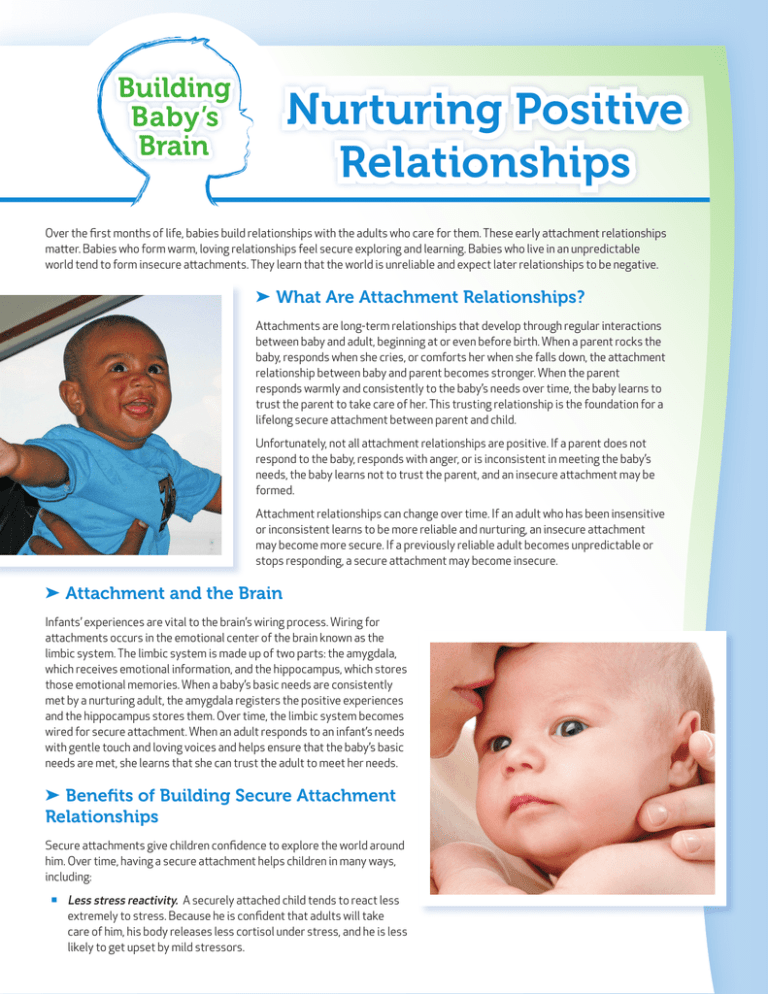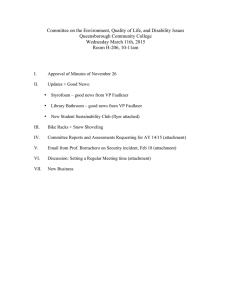Nurturing Positive Relationships
advertisement

Nurturing Positive Relationships Over the first months of life, babies build relationships with the adults who care for them. These early attachment relationships matter. Babies who form warm, loving relationships feel secure exploring and learning. Babies who live in an unpredictable world tend to form insecure attachments. They learn that the world is unreliable and expect later relationships to be negative. ➤ What Are Attachment Relationships? Attachments are long-term relationships that develop through regular interactions between baby and adult, beginning at or even before birth. When a parent rocks the baby, responds when she cries, or comforts her when she falls down, the attachment relationship between baby and parent becomes stronger. When the parent responds warmly and consistently to the baby’s needs over time, the baby learns to trust the parent to take care of her. This trusting relationship is the foundation for a lifelong secure attachment between parent and child. Unfortunately, not all attachment relationships are positive. If a parent does not respond to the baby, responds with anger, or is inconsistent in meeting the baby’s needs, the baby learns not to trust the parent, and an insecure attachment may be formed. Attachment relationships can change over time. If an adult who has been insensitive or inconsistent learns to be more reliable and nurturing, an insecure attachment may become more secure. If a previously reliable adult becomes unpredictable or stops responding, a secure attachment may become insecure. ➤ Attachment and the Brain Infants’ experiences are vital to the brain’s wiring process. Wiring for attachments occurs in the emotional center of the brain known as the limbic system. The limbic system is made up of two parts: the amygdala, which receives emotional information, and the hippocampus, which stores those emotional memories. When a baby’s basic needs are consistently met by a nurturing adult, the amygdala registers the positive experiences and the hippocampus stores them. Over time, the limbic system becomes wired for secure attachment. When an adult responds to an infant’s needs with gentle touch and loving voices and helps ensure that the baby’s basic needs are met, she learns that she can trust the adult to meet her needs. ➤ Benefits of Building Secure Attachment Relationships Secure attachments give children confidence to explore the world around him. Over time, having a secure attachment helps children in many ways, including: Less stress reactivity. A securely attached child tends to react less extremely to stress. Because he is confident that adults will take care of him, his body releases less cortisol under stress, and he is less likely to get upset by mild stressors. More independence. By about 18 months, a securely attached child tends to be more willing to try new things and to explore because his limbic system is wired to trust the adult to be there if he needs help. Better problem solving. Some researchers have found that securely attached children tend to be better problem solvers at age 2 than insecurely attached children, possibly because they are more willing to try new things and to risk failure. Better relationships. A child who was securely attached as an infant tends to form better relationships with other children in preschool. Secure, early attachment helps the child better understand how to negotiate later relationships. ➤ What Can You Do? The most important thing parents and caregivers can do is create nurturing and predictable environments for young children. Here are some ways to help your baby build secure attachment relationships: Be sensitive to your baby’s needs. Pay attention to your baby’s cues. Does she have a certain cry when she is hungry or sick? How does she let you know if she is bored or tired? As you read and respond to your baby’s needs and feelings, she will trust that you will take care of her. Offer positive and consistent guidance. A baby feels safe and secure when parents set clearly defined and age-appropriate rules for behavior. Set rules with love and respect, and be consistent in guiding your child to more appropriate behavior every time he breaks rules. Respect your baby’s feelings. When your child is angry or upset, take time to try to understand why he is feeling that way. Use language to help your child express his feelings. You might say, “It looks like you are angry because John took your toy.” Giving him words helps him learn to identify his own feelings and enables you to respond appropriately and effectively. Have fun together as often as possible. Make time daily to enjoy your baby’s company. Little moments spent singing a song, playing a rhyming game, or reading a book can build relationships. These little moments help strengthen connections in the brain, and they are the times you and your child will remember most. Choose high-quality child care. If you are placing your child in child care (at a center, at someone’s home, or by hiring someone to come into your home), be sure the person is warm, loving, and knowledgeable about child development. Visit potential child care programs ahead of time, and pay attention to what you see and hear. Ask questions about caregivers’ education and experience. If your state rates child care programs, check out those ratings to choose the best-quality place for your child. Selected References: Bales, D. W., Falen, K., Butler, T., Marshall, L. E., Searle, L., & Semple, P. (2012). Better Brains for Babies Trainer’s Guide, (2nd ed.). Belsky, J., & Nezworski, T. (1988). Clinical implications of attachment. Hillsdale, NJ: Lawrence Erlbaum Associates. Cassidy, J. (2010). Handbook of attachment:Theory, research, and clinical applications (2nd ed.). New York, NY: Guilford. Goldberg, S. (2000). Attachment and development. New York, NY: Oxford University Express. Vacca, J. J. (2001). Promoting positive infant-caregiver attachment: The role of the early interventionist and recommendations for parent training. Infants and Young Children, 13, 1-10. For more information about brain development, visit www.bbbgeorgia.org Circular 1053-09. Revised August 2014. Written by: Dr. Diane Bales, Associate Professor and Extension Human Development Specialist Supported by the University of Georgia College of Family and Consumer Sciences “Strengthening Georgia Families and Communities” Initiative. The University of Georgia, Fort Valley State University, the U.S. Department of Agriculture and counties of the state cooperating. UGA Extension offers educational programs, assistance and materials to all people without regard to race, color, national origin, age, gender or disability. The University of Georgia is committed to principles of equal opportunity and affirmative action. If you have a disability and need assistance in order to obtain this fact sheet in an alternative format, please contact the College of Family and Consumer Sciences at (706) 542-7566. www.fcs.uga.edu/extension

